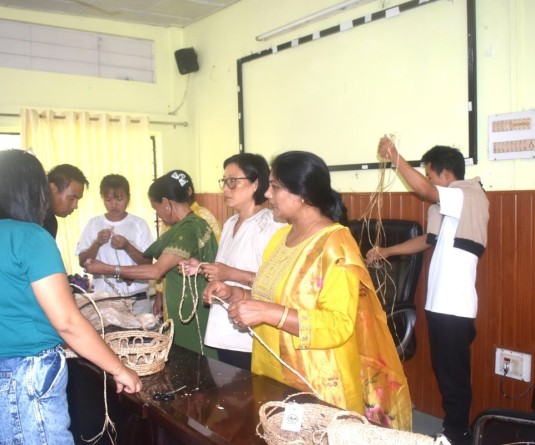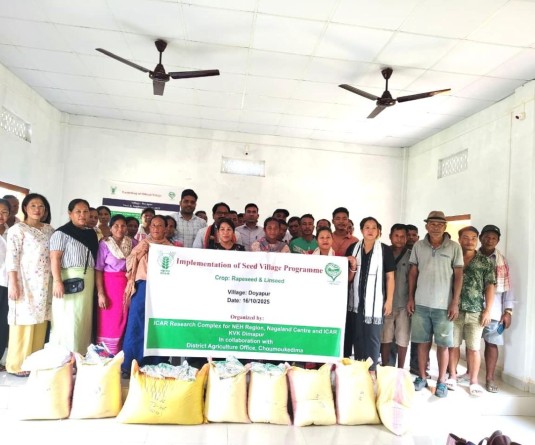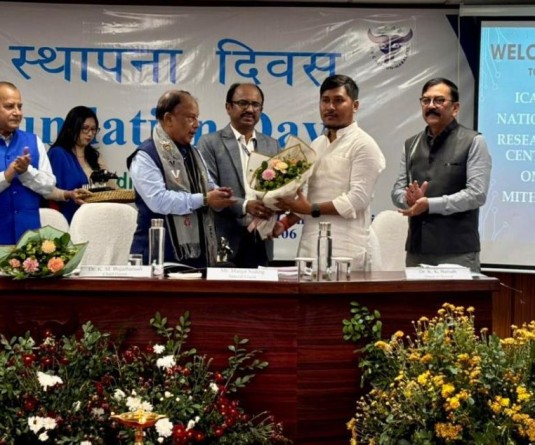
Tushnima Chaudhuri1 and Tasvina R. Borah2 PhD Scholar,
BCKV 2. Scientist, ICAR NEH Complex
Ornamentals are economically important commercial plants used for various purposes. The cultivation of ornamental plants has become an important segment of agri-horticultural economic enterprises and a lucrative sector of employment generation due to demand in International and Domestic markets. They are used in the floristry, gardening, landscaping and the environmental amenity industries. The demand for various ornamental plants for domestic consumption and export is increasing, more and more areas with other inputs are being diverted for their cultivation. This intensive propagation invites a number of diseases that adversely affect growth, vigour, survival ability of plants and also the yield and quality of these crops.
The ornamental crops, namely, Dracaena fragrans victoriae of family Asparagaceae and Aglaonema earnesto favourite of family Araceae have their importance as indoor ornamentals which help in air purification and humidity control whereas Dianella tasmanica variegata of family Asphodelaceae has great aesthetic value because of its blue flowers. They are affected by different kinds of fungal, bacterial, viral and nematode diseases as reported several times from various parts of the world including India. The various important diseases of the ornamental plants are enlisted below:
| Anthracnose of Draceana | Colletotrichum dracaenophilum |
| Tip blight of Draceana | Botryodiplodia theobromae |
| Anthracnose of Aglaonema | Gloeosporium graffi |
| Anthracnose of Dianella | Colletotrichum gloeosporioides |
| Tip blight of Dianella | Lasiodiplodia theobromae |
Disease attack on ornamental plants lead to total failure as the sole purpose of growing the plants are marred with the disease symptoms. The key to managing these diseases lies in the environmental conditions that favour disease development. High humidity and long leaf wetness period are the major driving factors for disease development along with other nutritional and environmental factors.
CONTROL MEASURES
Managing ornamental diseases begins with maintaining adequate nutrition and irrigation, adopting appropriate cultural practices and providing the right environment for plants. Fungicides should to the last resort to manage the diseases owing to the human and ecological hazards as well as the cost involvement. Moreover to keep the diseases at bay, it is critical to adopt a disease management program before getting to the point where fungicide applications are necessary.
When we consider options for plant disease management it is important to consider how our management plans augment disease development. The chain of events that leads to the development of a disease is called the disease cycle – which may be different to the pathogen's life cycle. The first requirement for the establishment of a disease is for the pathogen to come into contact with the host.
Pathogen
The pathogen is the causal agent of plant disease. In many instances, these pathogens are not widely distributed. Once problem is known, we should document it and initiate a management program. Few pathogen moves with soil and infected plant material and is not air borne.
Host
Cultivar or species selection according to the suitable environmental conditions becomes the main component to avoid disease development at the first step. The more susceptible the plant material, the more will be the overlap with the pathogen if it is present. Therefore, when planning the landscape, you should consider the prominent diseases in the area. Selecting plant species that are not susceptible or cultivars that are resistant or tolerant to common diseases, will lower their disease potential.
Environment
We might expect to have only limited control of the environmental component of the disease cycle. Assuming we have an active pathogen and a susceptible host, the next thing we need for disease problems to occur is a favorable environment, but at times our cultural practices will impact this component needed for disease development. For example, irrigation timing contributes to disease development. By avoiding irrigating at times, such as evening, where leaves will remain wet for long periods, the development of many foliar diseases can be limited.
However, Integrated disease management (IDM) is a cornerstone of floriculture and nursery crop production: strategies include sanitation, clean stock, host resistance, and control through biological, cultural, environmental, chemical, and regulatory means. Sanitation measures and cultural controls must keep pace with new production technologies. Clean stock programs are used for many crops that are propagated vegetatively. Breeding, selection, and biotechnology provide crops resistant to pathogens. Offshore production for economic competitiveness can introduce pathogens that make regulatory programs necessary. New biocontrol and chemical products continue to improve control while meeting the requirement for minimal environmental impact. Introduction of new crops and implementation of new production technologies gives advantage to the pathogens to exploit and attack.






